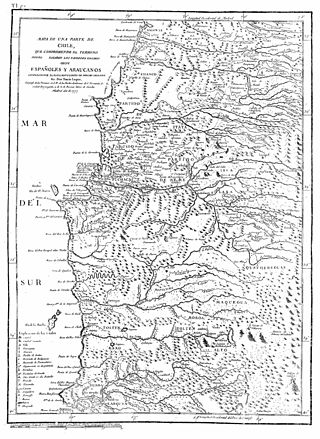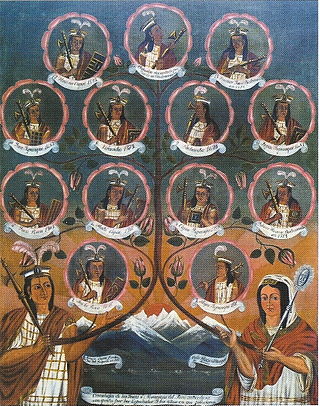
Túpac Amaru was the last Sapa Inca of the Neo-Inca State, the final remaining independent part of the Inca Empire. He was executed by the Spanish following a months-long pursuit after the fall of the Neo-Inca State.

Inca Garcilaso de la Vega, born Gómez Suárez de Figueroa and known as El Inca, was a chronicler and writer born in the Viceroyalty of Peru. Sailing to Spain at 21, he was educated informally there, where he lived and worked the rest of his life. The natural son of a Spanish conquistador and an Inca noblewoman born in the early years of the conquest, he is known primarily for his chronicles of Inca history, culture, and society. His work was widely read in Europe, influential and well received. It was the first literature by an author born in the Americas to enter the western canon.
Túpac Huallpa, original name Auqui Huallpa Túpac, was the first vassal Sapa Inca installed by the Spanish conquistadors, during the Spanish conquest of the Inca Empire led by Francisco Pizarro.
The Picunche, also referred to as picones by the Spanish, were a Mapudungun-speaking people living to the north of the Mapuches or Araucanians and south of the Choapa River and the Diaguitas. Until the Conquest of Chile the Itata was the natural limit between the Mapuche, located to the south, and Picunche, to the north. During the Inca attempt to conquer Chile the southern Picunche peoples that successfully resisted them were later known as the Promaucaes.

The Arauco War was a long-running conflict between colonial Spaniards and the Mapuche people, mostly fought in the Araucanía region of Chile. The conflict began at first as a reaction to the Spanish conquerors attempting to establish cities and force Mapuches into servitude. It subsequently evolved over time into phases comprising drawn-out sieges, slave-hunting expeditions, pillaging raids, punitive expeditions, and renewed Spanish attempts to secure lost territories. Abduction of women and war rape was common on both sides.

The Battle of the Maule was fought between a coalition of Mapuche people of Chile and the Inca Empire of Peru. Traditionally this battle is held to have occurred near what is now Maule River, in Central Chile. The account of Garcilaso de la Vega depicts the three-day battle, which is generally believed to have occurred in the reign of Tupac Inca Yupanqui.

The Incas were most notable for establishing the Inca Empire which was centered in modern-day South America in Peru and Chile. It was about 2,500 miles from the northern to southern tip. The Inca Empire lasted from 1438 to 1533. It was the largest Empire in America throughout the Pre-Columbian era. The Inca state was known as the Kingdom of Cuzco before 1438. Over the course of the Inca Empire, the Inca used conquest and peaceful assimilation to incorporate the territory of modern-day Peru, followed by a large portion of western South America, into their empire, centered on the Andean mountain range. However, shortly after the Inca Civil War, the last Sapa Inca (emperor) of the Inca Empire was captured and killed on the orders of the conquistador Francisco Pizarro, marking the beginning of Spanish rule. The remnants of the empire retreated to the remote jungles of Vilcabamba and established the small Neo-Inca State, which was conquered by the Spanish in 1572.

Cauquenes, a city and commune in Chile, is the capital of the Cauquenes Province and is located in the Maule Region.

The Comentarios Reales de los Incas is a book written by Inca Garcilaso de la Vega, the first published mestizo writer of colonial Andean South America. The Comentarios Reales de los Incas is considered by most to be the unquestioned masterpiece of Inca Garcilaso de la Vega, born of the first generation after the Spanish conquest.

El Quisco is a Chilean city and commune in San Antonio Province, Valparaíso Region. Located in the country's central coast, it serves as a popular summer resort for the population of Santiago and forms part of the Coast of Poets, a cultural space named after four world-renowned Chilean poets: Pablo Neruda, Vicente Huidobro, Violeta Parra and Nicanor Parra. El Quisco is home to La Casa de Isla Negra, the former house of Chilean poet Pablo Neruda, which is now a museum and Neruda's burial site.

The Conquest of Chile is a period in Chilean historiography that starts with the arrival of Pedro de Valdivia to Chile in 1541 and ends with the death of Martín García Óñez de Loyola in the Battle of Curalaba in 1598, and the destruction of the Seven Cities in 1598–1604 in the Araucanía region.
Aillarehue or Ayllarehue ; a confederation of rehues or family-based units (lof) that dominated a region or province. It was the old administrative and territorial division of the Mapuche, Huilliche and the extinct Picunche people. Aillarehue acted as a unit only on special festive, religious, political and especial military occasions. Several aillarehues formed the Butalmapu, the largest military and political organization of the Mapuche.
The Mapuche were a bellic culture, and their history was plagued by wars and conflicts since they began to settle in the Araucanía; they believed that history was created through warfare, and thus engaged in many military conflicts.
Butalmapu or Fütalmapu is the name in Mapudungun for "great land", which were one of the great confederations wherein the Mapuche people organized themselves in case of war. These confederations corresponded to the great geographic areas inhabited by the Mapuches in Chile.

Pukara de La Compañia is an archaeological site containing the remains of a promaucae fortress, later used by the Incas, located on the large hill overlooking the village of La Compañia, a village in the commune of Graneros, Chile. It is the southernmost building which remains of the Inca Empire. As such it is an important landmark on what is known as "The Chilean Inca Trail", and has been declared a National Monument by the Chilean government.

Inca rule in Chile was brief, it lasted from the 1470s to the 1530s when the Inca Empire was absorbed by Spain. The main settlements of the Inca Empire in Chile lay along the Aconcagua, Mapocho and Maipo rivers. Quillota in Aconcagua Valley was likely the Incas' foremost settlement. The bulk of the people conquered by the Incas in Central Chile were Diaguitas and part of the Promaucae. Incas appear to have distinguished between a "province of Chile" and a "province of Copayapo" neighboring it to the north. In Aconcagua Valley the Incas settled people from the areas of Arequipa and possibly also the Lake Titicaca.

Sinchiruca was an Incan military commander and a Grand General (Apusquipay) active in late 15th century. A relative of the ruling Inca Tupac Yupanqui, he was named one of the principal commanders of the Inca campaign against the Mapuche that ended with the disastrous Battle of the Maule.

The history of Cusco (Peru), the historical capital of the Incas.

The Second part of the royal commentary better known as the General history of Peru, is a historical literary work written by Inca Garcilaso de la Vega, the first Peruvian and Spanish mestizo of intellectual renown. It was published in 1617, in Córdoba, Spain, a year after the death of its author, and was dedicated to the Virgin Mary. It is the continuation of the Comentarios reales de los incas, and was published in a crucial period of the history of Peru, which began with the arrival of the Spanish and ended with the execution of the final Inca of Vilcabamba, Túpac Amaru I, in 1572. Aside from the historical motive of the text, the author sought through this second part of his work to praise his Spanish heritage, as he had done with his indigenous heritage in the first part of his work.

Amaru Topa Inca, also known as Amaru Inca Yupanqui, was an Inca prince and co-ruler of the Hanan dynasty, who reigned around 1450. He was the son of Pachacuti and Mama Anawarki. Around 1450, Pachacuti decided to name him his co-ruler and successor. His reign lasted between five and ten years.













